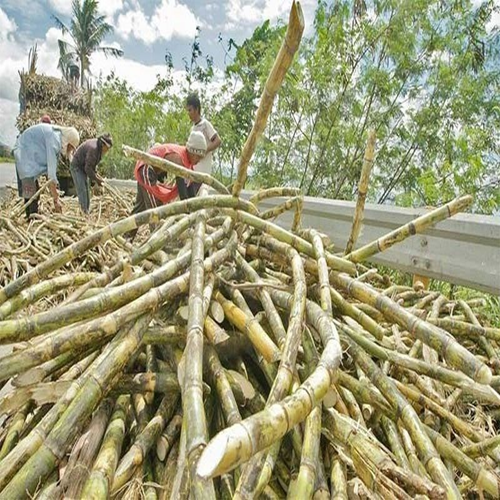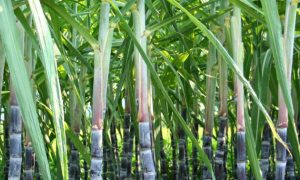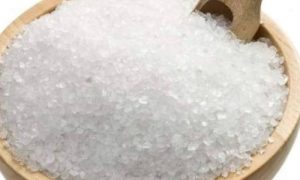This sugar is no longer swee

Despite Papalanto’s historical significance in sugarcane production, challenges like land developments and non-native dominance threaten its legacy. Nigerian sugar production, though lagging behind, faces infrastructural and economic hurdles. The collapse of local sugar factories and influx of non-native farmers exacerbate the decline. Despite this, local traders like Animot Majekodunmi persist, preserving tradition through sugarcane sales. However, without intervention, Papalanto’s sugarcane industry faces an uncertain future.
AGRICULTURE has long been the mainstay of Nigeria’s economy, employing a significant portion of the population while contributing greatly to the country’s gross domestic product (GDP). However, challenges such as outdated farming practices and limited infrastructure continue to hinder its full potential. One of the agricultural mainstays for the Nigerian economy was sugarcane production which was extensively exploited in the Papalanto area of Ogun State.
For many years, Papalanto, located in Ewekoro Local Government Area of Ogun State, is popular as one of the locations where sugarcane (Saccharum officinarum) is grown and largely cultivated in Nigeria. The once famous sugarcane plantation is now a shadow of itself. Papalanto is the intersection of the Ilaro-Sagamu highway and Lagos-Abeokuta expressway; it is some 22 kilometres from the Federal Polytechnic, Ilaro.
Checks by Sunday Tribune showed that during the Àdùbí War (Ogun Àdùbí) of 1918, the Egba soldiers took refuge at Pápá Ìrèkẹ́ (Sugarcane field) and they solely survived on sugarcane juice; a significant event that became the inspiration behind Tunji Oyelana’s song – Ogun Adubi.
A drive from Ewekoro to the road towards Sagamu gives you the allure of a large expanse of land, measuring thousands of hectares, that was once used to cultivate sugarcane. But today, the large expanse of land has been sold to estate developers either for construction of houses or establishment of factories and companies.
Planting of sugarcane has been in existence since the 18th century in Papalanto and the patronage steadily increased to the extent that other tribes, such as the Hausa and Igedes now earn their living through the sale of sugarcane.
Though sugarcane is still famous in the town, the present-day fame is nothing compared to what it used to be decades ago.
According to the United States Department of Agriculture, Foreign Agricultural Services (FAS), Nigeria comes behind South Africa as the second largest sugar market for sugarcane in sub-Saharan Africa while Nigeria produces less than 5 percent of the total consumed sugar.
Sugar refineries capacity in Nigeria is said to have increased from 2.75 million metric tons per annum in 2019 to 3.4 million metric tons per annum in 2020 but operating at less than 70 percent capacity. Currently, Nigeria has 210 percent refinery capacity over the annual import quota.
The report identifies farms and refineries in Nigeria as “Dangote Sugar operating three plantations: Savannah in Adamawa State, Lau Tau in Taraba State and Tunga in Nasarawa State. Products from these farms are processed by the refinery located in Adamawa, while the Lagos State refinery processes imported raw sugar.
“Golden Sugar operates a sugar estate in Sunti, Niger State, with one refinery in Lagos State. BUA Group owns two plantations: Lasuco in Kwara State and Bassa in Kogi State. The company’s two refineries are in Lagos and Port Harcourt with a combined installed capacity of 1.44 million 7 metric tons per annum.
“BUA Port Harcourt Refinery (850,000mt) is in Bundu Free Zone in Port Harcourt, River State. In addition, other greenfield sugar projects being developed under the NSMP include the Gagarawa Sugar Project in Gagarawa, Jigawa State, the Contec Global Project in Isanlu Esa, Kogi State, Gummi Sugar Project in Zamfara State, Sean-Zara Sugar Project in Kwara State, Crystal Sugar Project in Jigawa State, Oyo State Sugar Processors Ltd, Iseyin, Oyo State, Goronyo Sugar Project in Goronyo, Sokoto State and Cocaset Sugar, Ondo State.”
Neither Ogun State nor Papalanto was mentioned on the list by FAS despite the age-long culture that existed amongst the people.
The decline in sugarcane production in Nigeria became more pronounced in the early 2000 because of the collapse of two Federal Government-owned sugar factories.
Factors that have contributed to low sugarcane productivity include but are not limited to lack of good varieties, dependence on rain-fed production, excessive cost of inputs, lack of appropriate technology, minimal use of good agricultural practices, and lack of access to credit facilities.
The cost of sugarcane production is higher in Nigeria due to the absence of infrastructure.
Coming from the aforementioned, one would expect that at least a sugar factory would have existed in the area owing to the abundance of sugarcane but none is in sight and the practice continues to face threats.
Aside from being threatened by land developments, many natives have given up on sugarcane agriculture by taking up other enterprises. The introduction of a new variety of sugarcane also affected the practice while the operation of the sugarcane business has now been taken over by non-natives.
To salvage what is left and to keep this age-long history alive, Animot Majekodunmi, popularly known as Iya Olori, leads a group of female businesswomen dealing in sugarcane. Every 15 days, they meet under a shed in the middle of the road opposite one of Africa’s largest cement factories, Lafarge. The group has been in existence for about 10 years.
This group coordinates sales of sugarcane to travellers whose transit along the road is slowed down by the various bad portions of Papa-Ewekoro road. Some of the customers make special requests of the traders who help them drain out water from the sugarcane. But such practice has never been on a large scale, hence they made more money hawking to travellers.
Majekodunmi started her business about 10 years ago, when a bunch of sugarcane (now selling for N200), was sold for N10.
Despite the over 2,000% upward move of price, Majekodunmi said sugarcane income was meaningful during the time a bunch sold for N10 compared to what is obtainable today.
Price was not only the change recorded in the business but also the variety of the sugarcane stem available for planting has changed from the era of ‘alawopa’ to the northern stem.
Majekodunmi told Sunday Tribune that the business that once fetched them more proceeds with which many traders built their houses could barely earn them a living today.
She explained that though the profit margin has widened, the current economy isn’t making the profit worth what it ought to be.
“I have been in this sugarcane business for about 10 years. We have seen the best of it and we have suffered the worst. We built our house from farming and selling of sugarcane. We are talking about the time when things were good.
“There’s almost no waste on the sugarcane stem. After cutting the part meant for chewing, the top is preserved for planting again. We sell the head, leafy part to some farmers. This is so that when they plant and harvest, they can consider us as off-takers in this stiff competition we are in. Some of the wastes are also collected by people who are into herbal medicine, they claim it heals typhoid fast.
“Some people also request that we help them cut and extract the water; at times, they make sugar from it. They come from far places. It’s a difficult exercise but we help them do it and they get as much as 25 litres. We make extra income aside from selling for consumption.
“Sales have gone down in recent times. Same for the number of indigenes involved in farming. They have sold lots of land that was once used for development. Another thing is that sometimes, merchants scam the farmers because they come to their farms, harvest sugarcane to transport to Lagos and won’t return with money to the farmers. This also discouraged them.
“We have also experienced some changes that we are not used to, first is the introduction of another variety of sugarcane which sells better. We also have a high influx of non-indigenes thriving in the sugarcane business. This has been a setback for sugarcane farming,” Majekodunmi told Sunday Tribune.
Adijat Abolaji is not a native of the area. She started the sugarcane business around 1994 when she first came to Papalanto.
Foreigners take over farming
Like Majekodunmi, her husband also has a farm but has stopped farming. She hypothesised that there is almost no indigene engaging in sugarcane farming, as non-natives seem to have taken over the business.
“I am not a native of this place. I was married here and I got into the business. When I got to Papa in 1994, we met our fathers selling a bunch of sugarcane for N10. We used to sell it to those travelling to Iseyin. Sugarcane was so valued then that one customer once went away with my tray of sugar cane while I went looking for change to give him.
“My husband had the farm because he’s from Abese. This was in 2002 when there was not much residential and industrial development in this area but we no longer farm because all land for farming has been sold; there’s no land again. The Hausa farmers are more into it because they brought their variety here and it looks good for business. They harvest and take to large-scale buyers in Lagos.
“A pack of harvested sugarcane from the farm sold for N100-N150 then but now we have only Igede and Hausa doing the business and you may not see a Yoruba person doing it. My husband’s farm has been graded and converted for residential use.
“There’s almost no native into a serious sugarcane plantation. It has now been taken over by people from the Northern extraction and the Igedes. We used to have ‘mafamipa and abalaye’ but these non-indigenes introduced another variety.
We still have the Northerners to contend with at the point of purchase. While we are negotiating with farmers to buy at N3,500 per stock, our northern counterparts will come to buy at N5,000 per stock. No farmer will want to refuse such an offer. Our Northern brothers pack the sugarcane in trucks to Lagos for already-waiting clients. We are left with crumbs to sell by the roadside.
“If we buy a pack for N3,500, we can make N8,000 – N9,000 in sales. We may sell two bundles daily, especially on Saturdays. The profit is not much today because things are expensive. The gain may be much but things are on the high side. If you are not careful, you may not see the profit because of personal needs and other expenses involved in sales. We thank God that we still make sales and we are not put to shame.”
How a sugarcane factory died prematurely
Despite being born and brought up in Abese, a popular sugarcane farming community in Papalanto, Funmilola Ayinde did not go into the business till about 10 years ago.
Now in her fifties, Ayinde recalled how her parents and others used to cultivate a large portion of land for sugarcane production, but none of her family members has a plantation as of today.
Ayinde told Sunday Tribune that a company came up in the area to process sugarcane but the company folded up due to the inability of the community to supply the required quantity for production.
“My mum used to sell sugarcane. I grew up in the business but I didn’t start till about 10 years ago. The sugarcane industry ought to have witnessed lots of advancement, one of which I could recall was a sugar factory, African Tiles, that was established in our village. They needed large supply of sugarcane but that demand could not be met at that time. That was how they packed up and converted the company to poultry.
“The company needed like 300 trucks but land cultivation had shrunk the sugarcane plantation and many off-takers were taking much of the harvest to Lagos. The company couldn’t proceed with operations, their equipment is still there in Abese,” she explained.
Speaking further, Ayinde buttressed what others told Sunday Tribune about the competition between natives and non-natives, adding that the native farmers have been drawn aback by the actions of non-indigenes.
She added that the farmers always go for the highest bidder and this has also affected availability in the area.
“There is a lot of competition. The people who buy to resell in Lagos usually make it difficult for us because what we want to buy for N2,000 from the farms, the non-indigenes may buy the same for N5,000. The farmer, who wants to make as much profit as possible so, he’ll sell to the middlemen.”
Ayinde concluded that though there is still a considerably larger cultivation in Abese, Sopade and other communities, the sugarcane production activities they grew up to know have dwindled.
Though the USDA FAS office in Lagos forecasts Nigeria’s ending stocks to be at 100,000 MT, it says the volume will remain unchanged because the Nigerian government’s sugar policies have not yet led to production increases that can increase stock levels.
Meanwhile, traders in Papalanto have collectively resolved not to give up sugarcane agriculture. They said though sugarcane farming may be endangered in the area, they will keep doing what they do to earn a living on the one hand and preserve the culture on the other hand.
Source Link : https://tribuneonlineng.com/this-sugar-is-no-longer-sweet/














